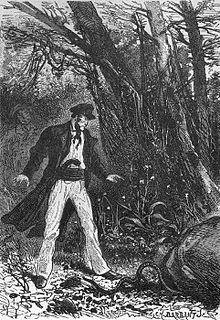A drama in Mexico

A Drama in Mexico (also The Liana Bridge ) is a short story by the French author Jules Verne and his first published prose work. Jules Verne had the original version of this short story until 1851 under the French title L'Amérique du Sud. Études historiques. Les premiers navires de la marine mexicaine and was first published in July 1851 in the Musée des familles . The short story originally had five chapters and a total of three illustrations by E. Forest and A. de Bar. These original drawings were later not used. In 1857 the short story was published in freely translated form in the family magazine Die Illustrirte Welt published by Eduard Hallberger in Stuttgart . The German-language title was Die Lianenbrücke . However, the author has been anonymized on this publication and the original title has been taken from L'Amérique du Sud. Études historiques. Changed Les premiers navires de la marine mexicaine to The Liana Bridge . The translator retold the story more than precisely translated it. The English title of the short story is A Drama in Mexico .
action
On October 18, 1825, the two Spanish warships Asia and Constanzia , which left their home ports with their crews over six months ago, call at the island of Guam , which at that time still belonged to the Philippines . There a mutiny develops , which is instigated by Lieutenant Martinez and the Mars guest José against the Spanish ship's command. The Spanish captain Don Orteva is responsible for the mission in the Pacific . The goal of the mutineers is to take control of the ships in order to sell them to the Republic of Mexico, which recently became independent through the revolution . The suddenly independent Mexico no longer had any protection of its ports after breaking away from Spain. Captain Orteva dies in the revolt on the ship. The mutineers take control of the ships. The officer candidate Pablo swears revenge on them out of loyalty to his fatherland and to his superior. Pablo and his comrade Jacopo break away from the mutineers who brought the two ships to the port of Acapulco to be handed over to the new government . The mutineer Martinez agrees with the governor of Acapulco that the legally valid deed of purchase can only be issued by the president of the new confederation in the capital, Mexico . Martinez and José set off for a ride in the capital.
However, on this trip they are haunted by bad luck. There is a near-accident with a poisonous snake , a spring where they want to replenish their water supplies has dried up and their horses are killed by a stone avalanche while they are resting. The superstitious villains see this as a bad omen. Martinez almost goes mad. Starved, they are surprised by a thunderstorm that night. Martinez murders José with a knife in order to get rid of the unpleasant eyewitness of the mutiny. Martinez comes rushed to a rocky canyon in which a wild river flows. A swaying bridge made of agave ropes spans the abyss. Martinez tries to cross the bridge. At the other end is Pablo. Martinez tries to turn back, but Jacopo is at the other end. Both cut the lianas and the bridge falls into the abyss with Martinez. The two warships fell into the lap of the Mexican government, so to speak.
literature
- Heinrich Pleticha (ed.): Jules Verne manual . Deutscher Bücherbund / Bertelsmann, Stuttgart and Munich 1992.
- Volker Dehs and Ralf Junkerjürgen: Jules Verne . Voices and interpretations of his work. Fantastic Library Wetzlar, Wetzlar 2005.
- Volker Dehs : Jules Verne . Jules Verne. A critical biography. Artemis & Winkler, Düsseldorf 2005. ISBN 3-538-07208-6
